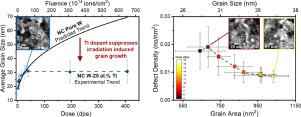Acta Materialia ( IF 9.4 ) Pub Date : 2021-01-08 , DOI: 10.1016/j.actamat.2021.116629 W. Streit Cunningham , Khalid Hattar , Yuanyuan Zhu , Danny J. Edwards , Jason R. Trelewicz

|
Deliberately designed nanostructured materials containing a high density of dopant stabilized interfaces provide energetically favorable sites for the annihilation of defects that form within the crystalline matrix due to irradiation. In this study, we explore the role of dopants on the mechanisms governing this behavior in a nanocrystalline W alloy doped with 20 at.% Ti using heavy ion irradiation experiments. Defect evolution is mapped in situ up to the saturation dose and bridged to extreme dose behavior using ex situ measurements with microstructural analysis focused on quantifying both the defect state and the impact of ion irradiation on the nanocrystalline grain structure. Compared with a nominally pure nanocrystalline W film, the W-20 at.% Ti alloy exhibits smaller defect loops and a delayed saturation dose with a period of irradiation induced grain growth occurring during transient damage accumulation. Microstructural evolution is modeled in the context of cascade-induced thermal spikes and reveals that the alloy evolves to a much finer nanocrystalline grain size relative to the predictions for pure W, indicative of Ti stabilizing the nanostructure against irradiation induced grain growth. In situ mapping of defect evolution during the growth of a single grain confirms the correlation between the global defect density trends and evolution of the microstructure, thus providing insights into the effect of Ti on the grain boundary sink strength through the transient defect accumulation and recovery stages.
中文翻译:

通过晶界掺杂抑制辐照诱导纳米晶钨中的晶粒生长和缺陷累积
精心设计的包含高密度掺杂剂稳定界面的纳米结构材料为消除由于辐照而在晶体基质内形成的缺陷提供了能量上有利的位置。在这项研究中,我们使用重离子辐照实验探讨了掺杂剂在控制这种行为的机理中的作用,该合金在掺有20at。%Ti的纳米晶W合金中。缺陷演化被原位映射到饱和剂量,并使用非原位桥接到极端剂量行为用微结构分析进行的测量集中于量化缺陷状态和离子辐照对纳米晶粒结构的影响。与名义上纯的纳米晶W膜相比,W-20 at。%Ti合金表现出较小的缺陷环和延迟的饱和剂量,并且在短暂的损伤累积期间会发生一定的辐照诱导晶粒长大。在级联引起的热尖峰的背景下对微观结构的演化进行了建模,揭示了相对于纯W的预测,合金演化到了更细的纳米晶粒尺寸,表明Ti稳定了纳米结构以防止辐照引起的晶粒生长。原位 单晶生长过程中缺陷演变的图谱证实了整体缺陷密度趋势与显微组织演变之间的相关性,从而提供了通过瞬态缺陷积累和恢复阶段Ti对晶界沉陷强度的影响的见解。



























 京公网安备 11010802027423号
京公网安备 11010802027423号